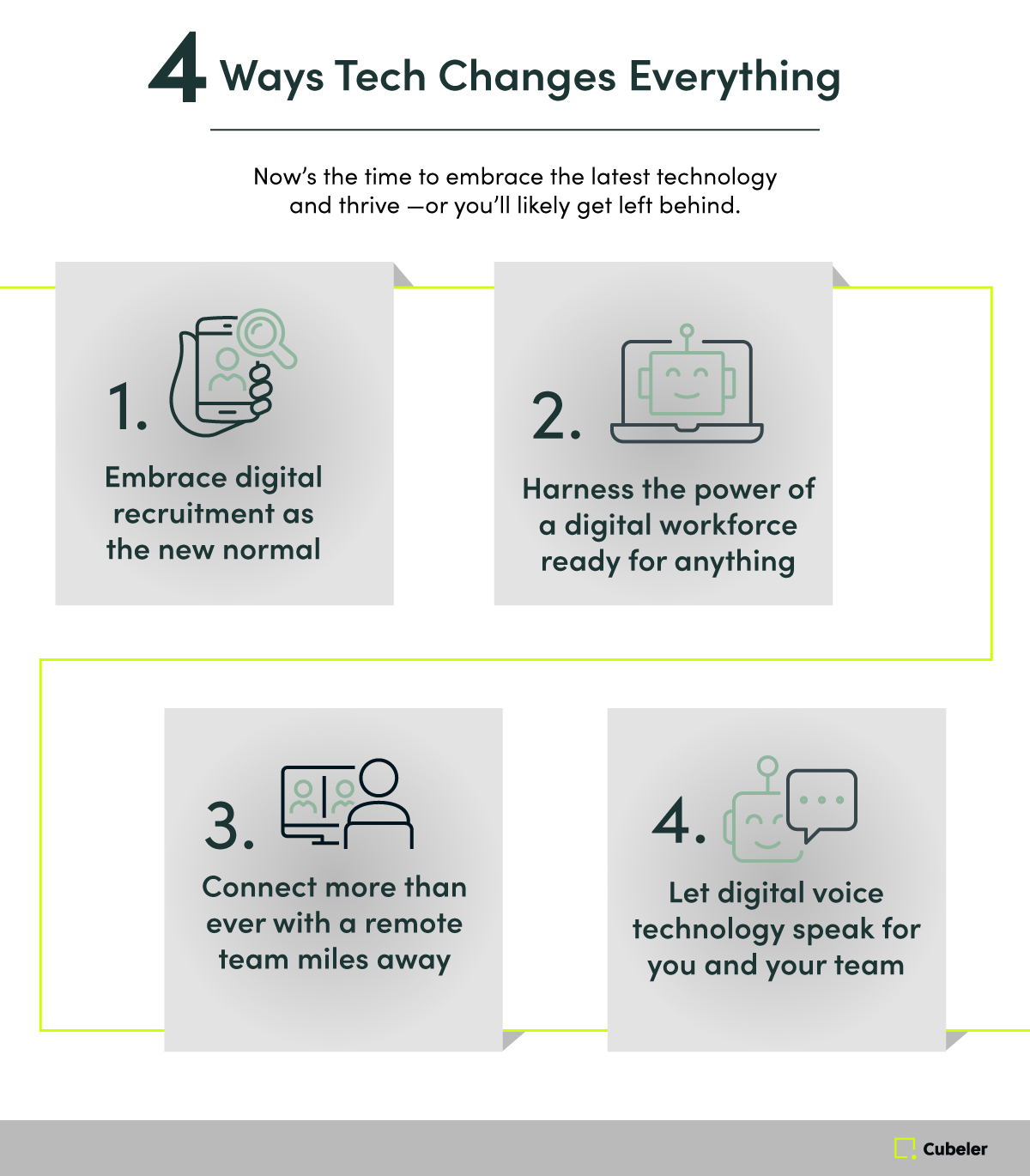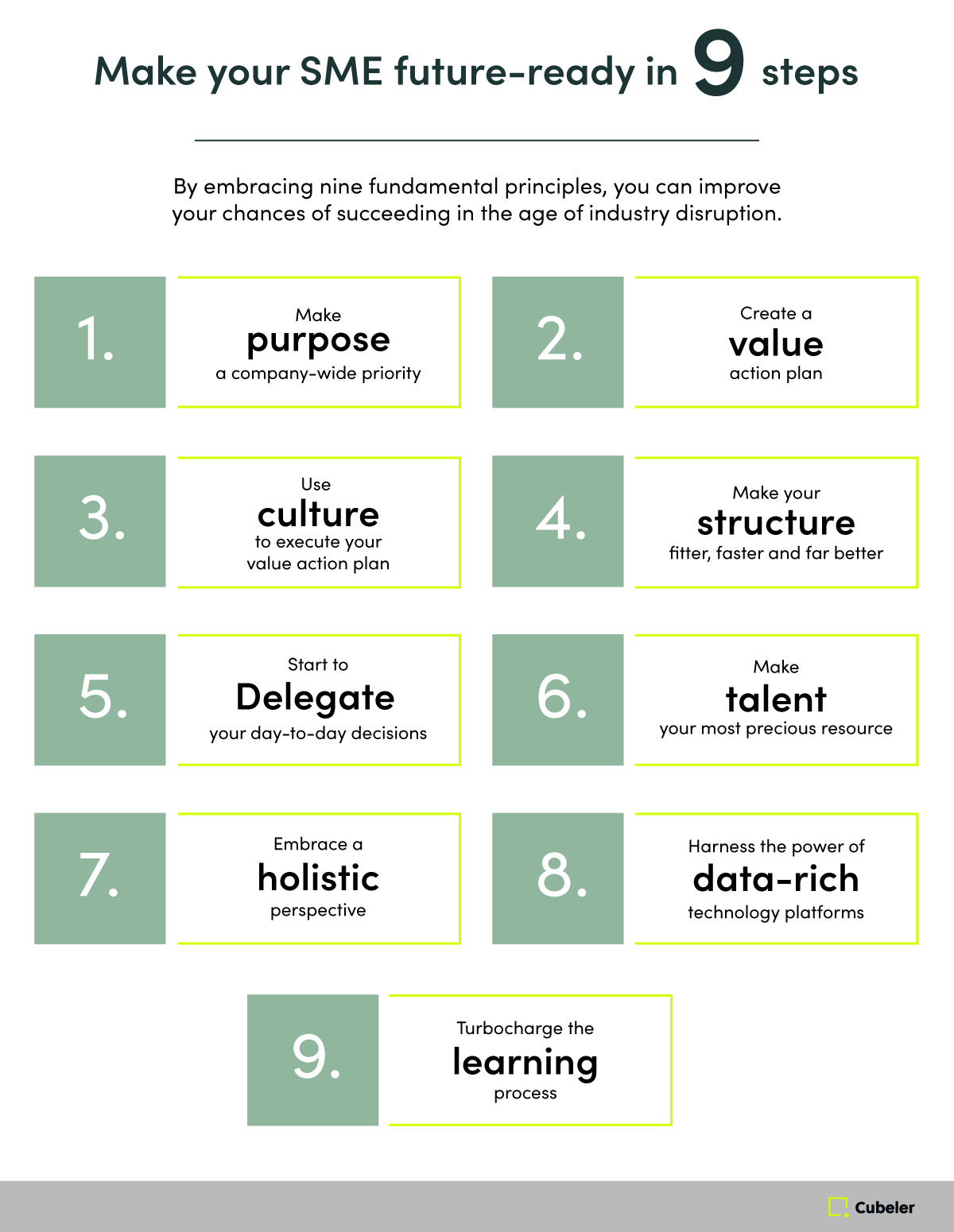Unlock the Power of Marketing: Get Your Free Marketing Plan Workbook
Enhance your marketing expertise with our free Marketing Plan Workbook, tailored specifically for small business owners...
7 min read
By:
Cubeler en-ca
21-Feb-2023 9:00:00 AM

Today, the key to success is not outdistancing your competition through sheer strength or intelligence—it’s by future-proofing your SME against industry disruption. Find out how to make your SME future-ready right here.
In the fast-paced world of business, the only constant is industry disruption.
Today, the key to success is not outdistancing your competition through sheer strength or intelligence—it’s by embracing and adapting to change. This, of course, begs the question: when is a good time to future-proof your business against industry disruption?
As the wise adage goes, forewarned is forearmed. The time to get ready for changes in your industry is not when it's already in motion, but prior to its arrival.
Reacting to disruptive industry forces on the spot keeps you on the defensive and can result in dire consequences. When you're constantly scrambling to keep up, you can't anticipate the future, and you can miss out on new opportunities.
Although finding the “ideal moment” to make your business change-ready can be challenging, there are many steps you can take as an SME owner to start on the right foot.
Technology is changing how we work at a never-before-seen pace
The past decade alone has seen a tremendous surge in technology advancements, from medical robots to digital banking, transforming the way we engage with the world and each other.
The workplace is one of the domains where technology has made an indelible impact. The rapid pace of advances in technology is dramatically transforming the traditional role of humans in the economy, prompting SME owners, managers and workers to rethink their roles.
Emerging trends in business and technology indicate that the modus operandi of employees—from where to when, why and how they work—will undergo radical changes in the coming decade.
With technology advancing at lightening speed, it's impossible to predict what’s in store for the SME world of work. However, one thing is for certain: if you don’t embrace technology today, your business may struggle to succeed in this era of industry disruption and be left behind.

4 Ways Tech is the Leading Edge of Change
Here are four ways to embrace technology that has dramatically changed—and will continue to change—how we work today and tomorrow.
1. Embrace digital recruitment as the new normal
Remote hiring has become the new normal—social media platforms such as LinkedIn and job boards like Glassdoor and Indeed can provide you with digital tools to source top talent at your fingertips.
You can now easily conduct the interview process conducted online, with platforms like Teams, Google Meet and Zoom.
Consider that it’s become common for individuals to work for companies without ever physically visiting the workplace, if there is one at all.
2. Harness the power of a digital workforce ready for anything
For many companies, a digital workforce is a solution that can significantly improve productivity.
A digital workforce encompasses different forms of technology, including AI and robotics, which work in collaboration with human employees to achieve business objectives.
Far from stealing our jobs, delegating certain tasks to machines can allow your and your team to focus on more important, higher-value work.
3. Connect more than ever with a remote team miles away
Remote working allows people who are miles apart to be more connected than ever.
An SME with the right technology can support its workforce remotely and, more importantly, successfully.
If your remote team can rely on strong lines of communication and plenty of support, you have every reason to go remote.
With remote working cutting commute times and letting employees work from anywhere with an internet connection, it’s the preferable option for many.
4. Let digital voice technology speak for you and your team
Contrary to popular belief, voice technology is not limited to smart home devices like Amazon Alexa.
In fact, many businesses use different voice technology platforms to conveniently interact with their customers, build communities, leverage existing digital assets through voice-enabled interfaces and platforms.
From virtual assistants to biometric verification, voice technology is revolutionizing the work environment, effectively providing companies with an extra set of (invisible) hands.
Now’s the time to embrace technology and thrive in this transformative age—or you’ll likely get left behind.
How to prepare your business for future industry disruption
While companies may recognize the need to adapt their business practices to thrive in a disruptive environment, the challenge lies in figuring out how to do it.
Even though no SME has yet mastered the formula, experience has shown that companies prepared for the future possess three key traits: a clear sense of identity and purpose, a focus on speed and simplicity, and a commitment to continuous learning, innovation and idea sourcing.
By embracing these fundamental principles—via nine key organizational priorities—SMEs can improve their chances of succeeding in the age of industry disruption.
1. Make purpose a company-wide priority
Your employees need to feel a strong connection to the purpose of the company—it’s the best way today to make them more motivated to do their best. According to a McKinsey study, employees who fulfill their purpose at work are four times more likely to have higher engagement levels compared to workers who don’t.
With a clear purpose, future-ready SMEs can provide a sense of direction during uncertain times, drive commitment, even uncover new business opportunities.
2. Create a value action plan
Future-ready SMEs tend to create value action plans—a roadmap that helps them breaks down their business goals into concrete organizational components, such as business units, regions, product lines, and even critical skills.
For you, the objective is to use a value action plan to focus your efforts and inspire a sense of what's truly important for every employee at your company.
With a clear value agenda, your business can not only effectively achieve its current strategic priorities, but it also gains the ability to adapt and reallocate resources as your priorities evolve.
3. Use culture to bring your value action plan to life (and your employees)
Future-ready SMEs set themselves apart through their culture—basically, the way they operate—to excel in today’s new era of business. Culture is much more than a catchy tagline.
Establishing clear principles and work practices is essential for creating a cohesive and sustainable company. And don’t play the imitation game—it’s far too challenging to replicate somebody else’s culture. Your culture should be tailored to your company's unique identity.
When SME leaders deliberately construct and cultivate the culture they want for their organization, they initiate a positive feedback loop. This attracts talent that can flourish within your unique culture, enabling your business to execute its value action plan and significantly boost performance.
4. Make your structure fitter, flatter, faster and far better
Future-ready SMEs are fitter, flatter, faster and far better at unlocking substantial value. Your goal here? Streamline your company structure, adopting the simplest model possible to enhance your performance in line with your business objectives.
For instance, you can adopt a model that leverages independent "micro-enterprises," consisting of small, agile teams that collaborate through networks of platforms and individuals to achieve the company's goals.
Another approach—the "helix model"— divides the reporting structure into two parallel lines of accountability, one focused on stability and the other on agility.
Either way, you’ll need to rethink your teams. Like many future-oriented companies, you can establish flexible networks of teams with diverse cross-functional skills and extensive experience to rapidly form, disband, reshape and test new business strategies.
5. Delegate most of your day-to-day decision-making
SMEs that can make decisions quickly and effectively have a system in place to properly delegate decisions to the right executives, teams, individuals and, yes, even algorithms.
The senior leadership team should concentrate their time and energy on critical business decisions that only they can make. Managers, in turn, should focus on allocating resources and talent. It’s crucial for everyone to be aware of who is responsible for what.
By managing resources from the top, you can accelerate and improve the quality of your decision-making. To prepare for the future, most of the day-to-day decisions you typically take on could probably be delegated to employees who report to you.
You already have the internal resources to enhance your decision-making. You just need to redesign your decision-making procedures for the future, sharing what you’ve have learned from experience with the right people within your organization.
6. Make talent your most precious resource
Today’s rapidly changing workforce demands a new approach to talent management. Future-ready SMEs must understand that their most valuable resource is their talent.
To attract the best talent, companies must create an inclusive workplace culture that supports employee growth, contributes to employee satisfaction and, ultimately, enhances the success of their business.
Additionally, these SMEs recognize the importance of a talent ecosystem, optimizing their talent management and allocation practices through technology-driven platforms to connect skills with projects, even outside their organization.
7. Embrace a holistic perspective
Future-ready SMEs recognize that their sources of value will continue to evolve and can't be solely derived from their core business. To succeed, they must excel at breaking down barriers, taking a holistic view rather than a linear one, and prioritizing flexibility over strict plans.
Ultimately, you need to view your partners as integral parts of your ecosystem, fostering open relationships built on trust and mutual reliance. This way, you can enable each partner to focus on their areas of expertise—for the long haul—and ensure shared success.
8. Harness the power of data-rich technology platforms
Future-ready SMEs understand the crucial role that data plays. For them, data is not just a way of tracking business performance or answering specific questions—it’s the driving force behind the business itself. They recognize the immense potential of data to continuously inform and enhance their decision-making and overall business strategy.
To tap into this potential, you must leverage effective data governance practices, adopt a modular approach to process design, harness the power of cloud technology and reallocate resources to new initiatives on a dime.
By using data to connect and scale, you can quickly launch new products and services, keeping your business at the forefront of your industry.
9. Turbocharge the learning process for your team
For SMEs to reach their full potential and cultivate a talented, empowered workforce, they must prioritize learning and foster a culture that embraces experimentation and continuous improvement.
High-performing organizations cultivate a mindset of continuous learning that encourages individuals to adapt, evolve and reinvent themselves to keep pace with a changing industry. This approach is characteristic of a true "learning organization."
In today's rapidly evolving business landscape, you may need to take a proactive approach to learning. Instead of organizing one-time training sessions, develop personalized learning journeys that blend core and individualized content that can be accessed on-demand through virtual learning environments, fueling both personal growth and innovation.

Quick takeaways
Today, the key to success is not through sheer strength—it’s by future-proofing your SME against industry disruption. Here’s how:
The time to get ready for changes in your industry is not when it's already in motion, but prior to its arrival.
To future-proof your company, you need to embrace digital recruitment as the new normal, harness the power of a digital workforce, build remote teams and let digital voice technology speak for you.
To succeed in the age of industry disruption, you must also make purpose a priority, execute a value action plan, make your business fitter, delegate decision-making, treat talent like gold, build data-rich tech platforms and turbocharge learning.

Enhance your marketing expertise with our free Marketing Plan Workbook, tailored specifically for small business owners...

Find out what you need to know to bypass the most common marketing pitfalls.

Expand your SME business network the right way. Learn how to connect with like-minded SME owners and decision-makers to...